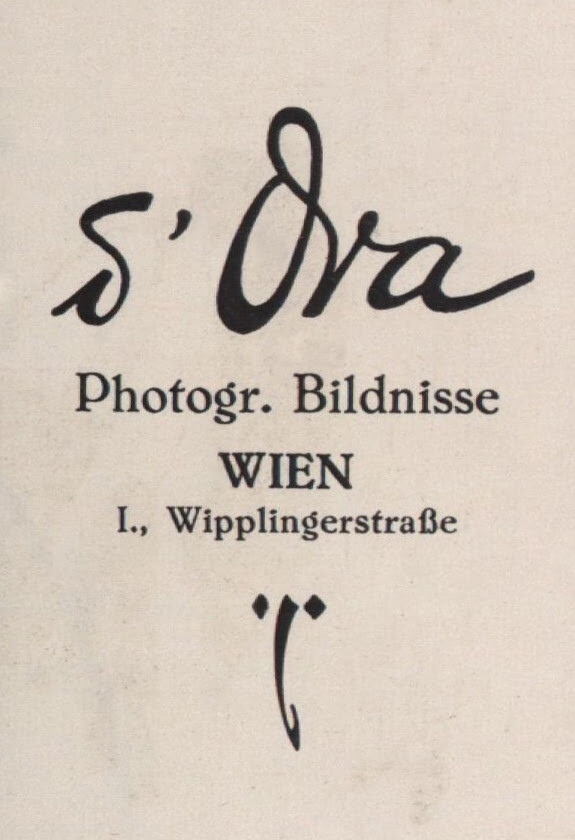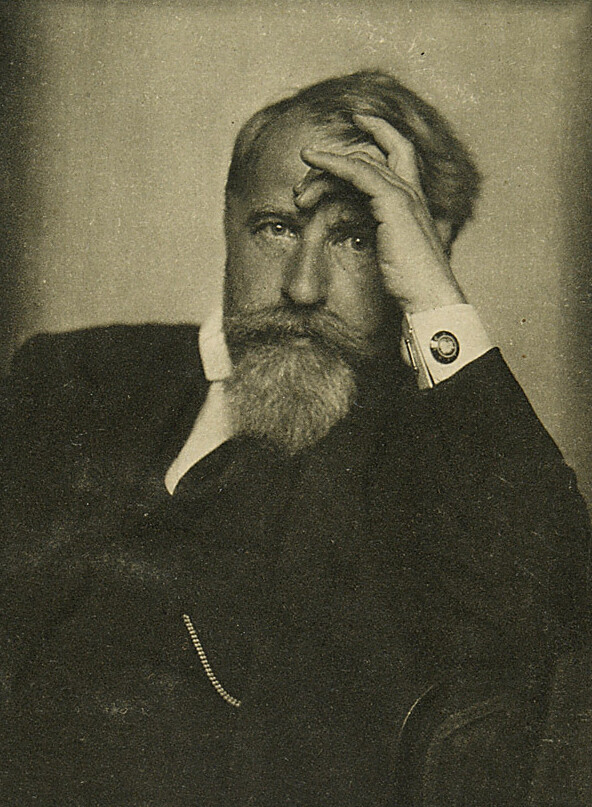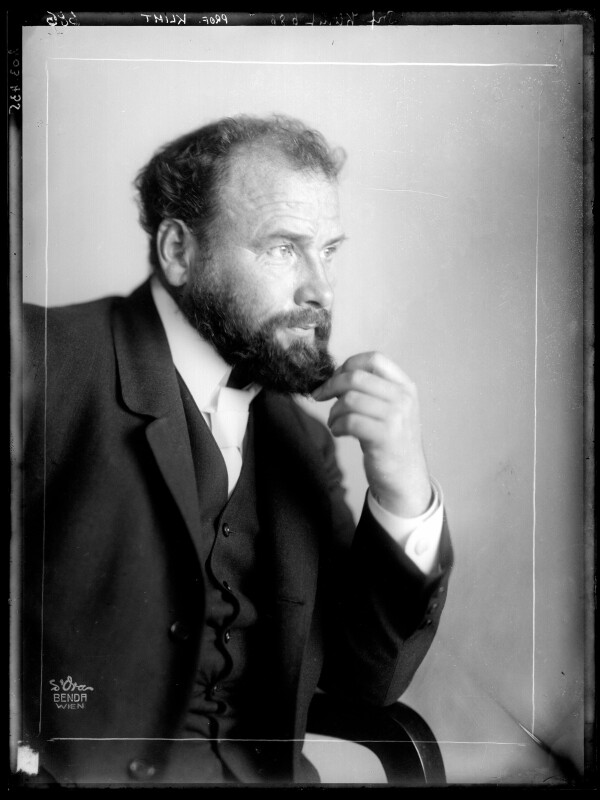Madame d'Ora

Advertisement of the Atelier d'Ora (detail), in: Wiener Frisierkunst und Mode, 6. Jg., Heft Juni (1921).
© ANNO | Austrian National Library

Arthur Schnitzler photographed by Madame d'Ora, 1915, Theatermuseum, Vienna
© KHM-Museumsverband

Gustav Klimt, 1908, Österreichische Nationalbibliothek, Bildarchiv und Grafiksammlung
© Picture Archives and Graphics Department, Austrian National Library
In 1907, Dora Philippine Kallmus began working under the pseudonym of “Madame d'Ora.” Through the portraits of her prominent clients, the participation in exhibitions, fashion photography, and the publication of her works in journals and fashion magazines at home and abroad, she became one of the most successful women photographers of her age.
Dora Philippine Kallmus was born into a bourgeois Jewish family in Vienna on 20 March 1881. Her father, Philipp Kallmus, was a lawyer and notary. After the premature death of her mother Malvine (née Sonnenberg), Dora and her sister Anna Malvine grew up with their grandmother.
Dora Kallmus took up photography in 1903 and in 1904 worked in the summer studio of photographer Hans Makart. Being a woman, she was bared from apprenticeship or enrolling at an institution to learn the trade. However, she was the first woman to receive a special permit and access the Graphische Lehr- und Versuchsanstalt [Institute of Graphic Education and Experiment] in Vienna, where she was allowed to attend theoretical courses, although she was denied the practical part of the training.
In 1905 she was admitted to the Vienna Photo-Club and to the Imperial-Royal Photographic Society as a member. On 2 May 1906 she received her trade license, which stated Schulerstraße 1 as her domicile, and began accepting portrait commissions.
In 1907, Kallmus moved to Berlin for six months to complete her training in photography, reproduction, and retouching with Nicola Perscheid. Back in Vienna, she opened her studio in the First District (Inner City) at Wipplingerstraße 24–26 under the pseudonym of “Madame d'Ora.” Arthur Benda, who had been Perscheid’s assistant in Berlin, was employed as technical director of her studio.
Although d’Ora photographed various personalities from Viennese society and aristocracy, she became mainly known for her portraits of artists and intellectuals, taking pictures of Carl Moll, Hermann Bahr, Arthur Schnitzler, Alexander Girardi, Emilie Flöge, Berta Zuckerkandl, Max Reinhardt, and Karl Kraus. In 1908 she also made a series of typically expressive portraits of Gustav Klimt. It comprised ten photographs showing the painter standing or seated, wearing a suit. They seem to have been taken at her studio. An article about “Das moderne Photographenatelier” [“The Modern Photographer’s Studio”], which appeared in 1908, describes her studio and her approach, which was reflected in her portrait photographs:
“At first she has to familiarize herself to some degree with the sitters she is about to photograph, so as to depict them in a manner that does justice to their peculiarities.”
She also succeeded in doing so when she photographed the coronation of Charles I of Austria in 1916 and took pictures of the entire imperial family in 1917.
From 1915 on, Dora Kallmus dealt with the theme and the photographic representation of dance, photographing the sisters Else and Bertha Wiesenthal. She arrived at new pictorial solutions featuring scenic arrangements and was in charge of image direction while Arthur Benda was behind the camera, seeing to the technical realization of the pictures.
From the very beginning, the publicity and presentation of her studio mattered a great deal to the efficient photographer. Thanks to numerous exhibitions at home and abroad, including shows at Kunstsalon Heller and Kunstsalon Keller & Reiner, as well as the publication of her pictures in such magazines as the Wiener Salonblatt, Sport und Salon, and Die Woche, she achieved great popularity. She became known for the artistic quality of her work and was able to expand her circle of customers. She was in close contact with the Wiener Werkstätte’s fashion department and soon also made a name for herself as an internationally successful art and fashion photographer.
From 1921 until well into the 1930s, Madame d’Ora operated a studio in Karlsbad [now Karlovy Vary] over the summers. Following several stays and fashion photography commissions in Paris from 1923 on, she settled there permanently in 1925, running her own studio. The studio in Vienna was attended to by her business partner Benda, who eventually purchased it in 1927 and after a quarrel was only allowed to continue operating it under the name of “d’Ora-Benda.” In Paris, Kallmus built on her success as a society and artists’ photographer, taking pictures of such renowned celebrities as Maurice Chevalier, Marc Chagall, Josephine Baker, Pablo Picasso, and Coco Chanel. Besides, she also worked as a fashion photographer for the big Parisian couturiers, including Lanvin and Chanel; she received commissions from such leading fashion magazines as Die Dame, Madame, Officiel de la Couture et de la Mode, and Vogue and published short texts. Her photographic style, based on contemporary fashion developments, reflected the aesthetics of the 1920s.
After the invasion of German troops in Paris she sold her studio in 1940, but continued to work as a photographer and write mostly autobiographical manuscripts. She planned to emigrate to the United States together with her sister Anna, but the latter was deported in 1941 and subsequently murdered. In 1942, Dora Kallmus escaped from the National Socialists to Southern France and was not able to return to Paris before late 1945.
Traumatized by the horrors of NS atrocities and as an expression of her experiences in exile, the photographer radically changed her aesthetic approach. Between 1946 and 1948 she photographed war damage in Vienna and Salzburg, refugee camps, and survivors from concentration camps. Beginning in 1949, she made shocking series of dead animals in the slaughterhouses of Paris. Aside from that, she continued to earn her living with her portrait and fashion photographs.
Dora Kallmus spent the last years of her life in Frohnleiten in Styria, where she died on 30 October 1963 and where she was also buried. Her mortal remains were exhumed in 2019 and transferred from Frohnleiten to the Jewish cemetery in Graz, where her final resting place is now in a tomb of honor. In 2017/18 and 2020 major retrospective exhibitions took place at the Museum für Kunst und Gewerbe in Hamburg, the Leopold Museum in Vienna, and the Neue Galerie in New York.
Literature and sources
- Monika Faber: Madame d'Ora Wien-Paris. Porträts aus Kunst und Gesellschaft 1907-1957, Vienna 1983.
- Lisa Silverman: Madame d'Ora, in: Jewish Women. A Comprehensive Historical Encyclopedia, 27, 2009, Jewish Women's Archive. jwa.org/encyclopedia/article/madame-dora (05/06/2020).
- Tamara Loitfellner: Dora Philippine Kallmus (10.07.2018). www.univie.ac.at/biografiA/daten/text/bio/kallmus.htm (07/10/2020).
- Monika Faber, Esther Ruelfs, Magdalena Vuković (Hg.): Machen Sie mich schön Madame d'Ora. Dora Kallmus Fotografin in Wien und Paris 1907-1957, Ausst.-Kat., Leopold Museum (Vienna), 13.07.2018–29.10.2018, Vienna 2018.
- N. N.: Das moderne Photographenatelier, in: Oesterreichische Volks-Zeitung, 22.03.1908, S. 12.
- N. N.: Genossenschaftliches. Mitteilungen der Genossenschaft der Photographen in Wien. Gewerbeanmeldungen (April bis Mai 1906), in: Österreichische Photographen-Zeitung, Heft 5 (1906), S. 78.
- N. N.: Das moderne Photobildnis. Aufnahmen von Mme D’Ora, in: Moderne illustrierte Zeitung für Reise und Sport. Theater und Literatur, Kunst, Mode und Fremdenverkehr, 13. Jg., Heft 4 (1913), S. 6-14.
- Jüdische Gemeinde Graz: Ehrengrab für Dora Kallmus. Fotografin zur ewigen Ruhe auf jüdischen Friedhof Graz überführt (24.10.2019). www.ots.at/presseaussendung/OTS_20191024_OTS0147 (05/06/2020).
- Wien Geschichte Wiki. Dora Kallmus. www.geschichtewiki.wien.gv.at/Dora_Philippine_Kallmus (05/06/2020).
- Friedrich Stern: Zwei hervorragende Vertreterinnen künstlerischer Bildnisphotographie, in: Neues Wiener Tagblatt, 04.02.1912, S. 18.
- Edda Engelke: Stolpersteine Graz. Anna Malvine Kallmus. www.stolpersteine-graz.at/ststeiermark/kallmus-anna/ (01/23/2023).

